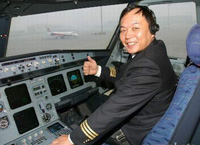
China's air passengers are expected to double over the next five years, and the explosive growth poses a major challenge in training enough qualified pilots to ensure flight safety, a top aviation official said in Beijing yesterday.
The number of air travelers in China will soar to nearly 280 million by 2010, said Gao Hongfeng, vice director of the General Administration of Civil Aviation of China.
Last year's 138 million figure was up 15 percent from 2004 and 105 percent from 2000, he said.
Total air traffic volume jumped 111 percent last year from five years ago while air freight rose 89 percent.
"Every year in the next five years, the country will add more than 100 planes, meaning we will need more than 1,000 pilots," Gao said. "We will face great pressure in training good pilots for these planes."
Given the current growth pattern, Chinese airlines may need 1,790 planes estimated to cost US$230 billion by 2023, according to Airbus SAS. And 40,000 pilots may be required in the coming 20 years to meet demand.
The country's rapidly growing aviation industry is already showing the effects of the lack of qualified pilots, authorities said.
Experienced pilots flying for the three big state-owned carriers - China Eastern Airlines, China Southern Airlines and Air China Ltd - have become highly sought after.
New private carriers are willing to spend more to get these pilots to fly their planes. And some carriers have started to hire foreign pilots to relieve the acute shortage.
Gao also said given the nation's heavy flight traffic, ensuring safety is a major challenge for China's aviation industry.
Beijing Capital International Airport, for instance, is operating beyond capacity. The airport is allowed to handle 1,000 flights a day but at present there is one takeoff or landing every minute.
"We've moved to control the number of flights to ensure safety," he said.
Gao stressed, however, that China's safety record in the past five years was better than the world average but lower than countries with advanced civil aviation industries. Figures on air crashes were not provided.
"The lack of aviation personnel, limited airspace and airports that can't keep up with demand are major challenges for China to improve safety," he said.
Efforts will be made to implement new technologies, enhance safety inspection systems and do more to meet international standards to improve safety, punctuality and air traffic control, he said.
(Shanghai Daily February 15, 2006)
|

